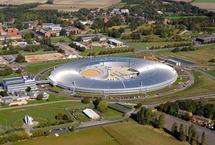Key to TB's 'staying power' unlocked

The first report of a biomolecular structure resolved using the Oxfordshire Diamond synchrotron is giving vital help in the fight against tuberculosis.
Oxford University scientists and colleagues have used Diamond’s ‘super microscopes’ to build a complete picture of HsaD: a protein that enables the tuberculosis bacteria to survive in the human body. Understanding the three-dimensional structure of the protein will help in the development of drugs to treat the disease.
Tuberculosis is the leading cause of death from an infectious agent worldwide, killing over 1.5 million people every year. Dr Isaac Westwood, a member of the Oxford team investigating HsaD, said: ‘It is only by continued collaborative and multidisciplinary research that we can gain a better understanding of this important pathogen, and to develop novel therapies to treat tuberculosis. New therapies are desperately needed, with increased incidence worldwide of multi- and extensively-drug resistant strains of Mycobacterium tuberculosis.’
A report of the research, published in a recent edition of Acta Crystallographica, describes how the scientists studying the genetic make-up of Mycobacterium tuberculosis, identified genes that enable it to survive within human cells. One of the genes encodes for HsaD, a protein that acts as a catalyst in the metabolism of cholesterol. The researchers then used the Diamond synchrotron to determine HsaD’s three-dimensional protein structure by X-ray crystallography.
‘Our research is the first step towards a detailed understanding of how the HsaD enzyme is involved in the pathogenicity and persistence of M. tuberculosis, commented Dr Westwood. ‘It is also the first step in the rational drug design process: where we can design potential drugs based on the 3D structure of essential biological molecules. The HsaD enzyme is one of several related enzymes which we are actively investigating as new targets against M. tuberculosis.’
‘This research will give vital information about a novel biochemical pathway in this organism, and also may lead to the development of new therapies which help to control the tuberculosis epidemic.’
The teams involved at Oxford University were in Pharmacology (Mr Nathan Lack, Dr Isaac Westwood, Professor Edith Sim) and Molecular Biophysics (Dr Ed Lowe, Professor Martin Noble), in collaboration with Dr Jie Liu and Professor Lindsay Eltis at the University of British Columbia in Vancouver.
Source: Oxford University




















